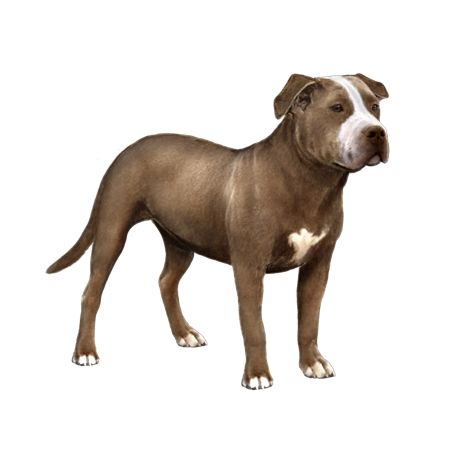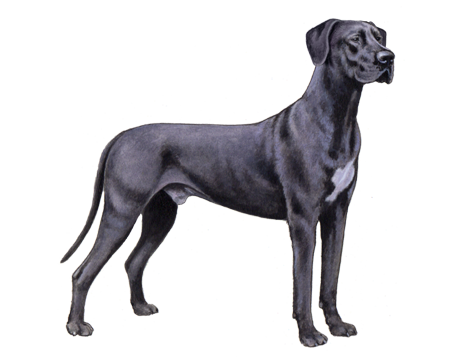
Dogue de Bordeaux
Dogue de Bordeauxs are intelligent and alert dogs. They bond closely with their people and are eager to please. This breed yearns for attention and companionship. So, if you're looking for a pup you can pamper with cuddles and kisses, the Dogue de Bordeaux might be right for you.
Interested in discovering if your dog is a Dogue de Bordeaux?
Check out Wisdom Panel's DNA tests.

Dogue de Bordeaux Traits
General Appearance
A powerful and muscular dog, the Dogue de Bordeaux is built like an athlete. The breed is strong, as well as relatively compact—ideal qualities for working dogs.
Coat and Coloring
The Dogue De Bordeaux's short coat comes in a range of fawns, from a pale fawn to a deep, reddish mahogany. White patches are also possible. A black or brown mask is a common trait in this breed, but even without a true mask, the muzzle may appear more reddish than the rest of the coat.
Distinctive Physical Traits
The Dogue de Bordeaux has a huge head and neck, prominent jaw, alert eyes, and an endearingly wrinkled brow. This is also a brachycephalic (a.k.a. short-snout breed).
Dogue de Bordeaux Temperament
Despite their considerable size, Dogue de Bordeauxs are friendly dogs with a warm, teddy bear-like disposition. They're remarkably calm with family and children. That being said, you should always supervise your dog when kids are around.
The Dogue de Bordeaux's personality ranges from a little distant to uninhibited, or even downright entertaining. Serious and self-assured with strangers, this breed is courageous enough to take action if something's gone awry—often barking to alert their owner.


Dogue de Bordeaux History
An ancient French breed, the Dogue de Bordeaux was originally bred in the 12th century to be a hunting dog. Over the years, it's also been used for guarding, herding, animal-baiting, and dogfighting.
Initially, there were three types of Dogues: Toulousain, Parisian, and Bordelais. The last of these is the ancestor of today's Dogue De Bordeaux. The breed's exact origins are unclear. A host of breeds—including various Mastiff- and Molossus-type guard dogs—likely contributed to the Dogue de Bordeaux as we know it today. In 1863, the breed officially earned its name after winning a competition in the first canine exhibition at the Jardin d'Acclimatation in Paris.
Though the number of Dogue de Bordeauxs dropped significantly during the French Revolution and two World Wars, it ultimately survived. And by the early 1990s, the breed's popularity in America began to rise—likely due, in part, to the film Turner and Hooch. The movie starred Tom Hanks as Officer Turner and a Dogue de Bordeaux as the always slobbering (yet adorable) Hooch. The American Kennel Club formally recognized the breed in 2008.
Dogue de Bordeaux Care
Nutrition
Dogue de Bordeauxs require a high-quality dog food that is age-appropriate. Be sure to keep an eye on the amount of food you give your Dogue de Bordeaux, and reduce portions if your pup gains weight. Also, remember that treats add up and, in excess quantities, can contribute to obesity.
Grooming
The Dogue de Bordeaux is an exceptional drooler. So, the dog's wrinkled face requires weekly (and sometimes daily) care to keep it clean and dry. Though short, this breed's coat sheds throughout the year. Regular brushing with a rubber curry or shedding blade can help keep loose hair under control.
As most dogs do, Dogue de Bordeauxs need their ears checked for debris or signs of infection, and nails trimmed about once a month. Similarly, one bath per month is usually sufficient unless your pup gets into something that makes them particularly dirty.
Exercise
To prevent developmental problems, you shouldn't allow your Dogue de Bordeaux to engage in excessive or high-impact exercise until at least 18 months old. So, no running up and down stairs or jumping from high surfaces. That being said, physical activity is important. Walks and playtime in the backyard are good options.
When they reach adulthood, Dogue de Bordeauxs may enjoy a range of dog sports. These could include agility, carting, rally and competitive obedience, weight pull, water rescue, and tracking.
Training
Because Dogue de Bordeauxs have historically been used to guard people and property, they require dedicated obedience training and early socialization to be well-mannered companions.
Sometimes described as stubborn, Dogue de Bordeauxs are sensitive dogs that may resist rough or forceful disciplinary measures. But they do respond well to reward-based techniques.

Dogue de Bordeaux Genetic Health Conditions
-
Canine Multifocal Retinopathy 1
Canine Multifocal Retinopathy 1 (CMR1) is an eye disorder that can cause retinal decay which may impact vision, but very rarely results in blindness.
-
Focal Non-Epidermolytic Palmoplantar Keratoderma
Focal Non-Epidermolytic Palmoplantar Keratoderma (FNEPPK) is an inherited skin disorder that causes a type of hereditary footpad hyperkeratosis (HFH). Signs include hard, thickened, and cracked footpads.
Knowing if your Dogue de Bordeaux is a carrier or at-risk for these conditions can help you and your veterinarian plan for your pup’s lifelong care. With Wisdom Panel™ Premium, you can get results for over 200 genetic health tests.
Breed Group
Guard
Dogs of the Guard Group were bred to guard people and property. They are often quick to learn and these intelligent, capable animals make solid companions.
Resources
https://www.akc.org/dog-breeds/dogue-de-bordeaux/
Reviewed July 26, 2020 by Annette Louviere, DVM























